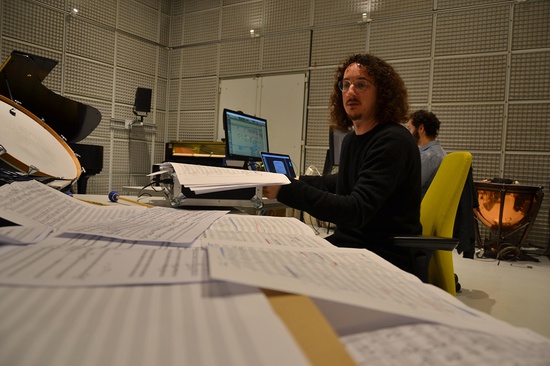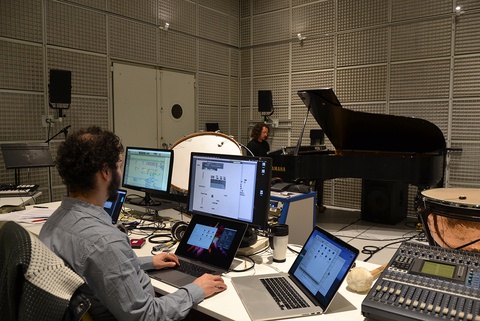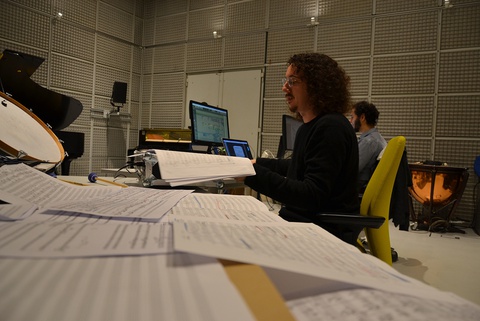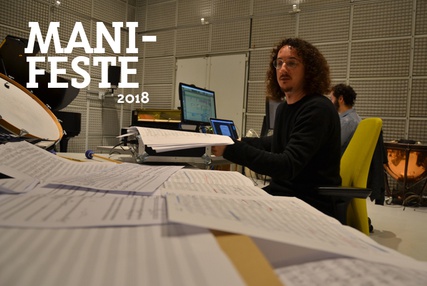Catharsis
Catharsis pour deux pianos, deux percussionnistes et électronique
Comme son titre l’indique sans ambages, le projet musical de cette pièce s’appuie sur le concept de « catharsis ». Signifiant en grec « séparation du bon d’avec le mauvais », le terme s’utilise en médecine ou en psychanalyse, mais la catharsis joue un rôle essentiel dans le rituel du théâtre antique puisque celui-ci a pour objet de « purifier » les passions du spectateur par le – une vision plus « actuelle » du concept voudrait que la catharsis, plutôt qu’un résultat du théâtre, soit un de ses prérequis : se défaire de ses passions pour mieux apprécier la représentation.  Quant à Didier Rotella, il applique le concept directement au matériau musical, au sens de la sublimation de ce matériau : à la manière d’un Thème et Variations – le compositeur donne d’ailleurs pour modèle les Variations Diabelli de Beethoven –, il fait subir à une petite figure, ou geste, instrumental et électronique diverses transformations. En mutant ainsi par petites étapes, sans jamais se présenter deux fois le même visage à l’auditeur, ladite figure impose à l’auditeur une écoute singulière. Ces variations – qui relèvent davantage des variations d’énergie que du matériau lui-même – consistent notamment en une « détempération » des pianos et des claviers de percussion (marimba, vibraphone, glockenspiel et xylophone) – c’est-à-dire que le compositeur les détourne graduellement du tempérament égal qu’on leur connaît et des harmonies qui s’ensuivent – jusqu’à l’abolition complète des hauteurs.
Quant à Didier Rotella, il applique le concept directement au matériau musical, au sens de la sublimation de ce matériau : à la manière d’un Thème et Variations – le compositeur donne d’ailleurs pour modèle les Variations Diabelli de Beethoven –, il fait subir à une petite figure, ou geste, instrumental et électronique diverses transformations. En mutant ainsi par petites étapes, sans jamais se présenter deux fois le même visage à l’auditeur, ladite figure impose à l’auditeur une écoute singulière. Ces variations – qui relèvent davantage des variations d’énergie que du matériau lui-même – consistent notamment en une « détempération » des pianos et des claviers de percussion (marimba, vibraphone, glockenspiel et xylophone) – c’est-à-dire que le compositeur les détourne graduellement du tempérament égal qu’on leur connaît et des harmonies qui s’ensuivent – jusqu’à l’abolition complète des hauteurs.
L’autre référence essentielle pour Rotella est Kontakte de Karlheinz Stockhausen. Dans cette pièce pour piano, percussion et électronique écrite entre 1958 et 1960, l’outil électronique est asservi à un véritable manifeste de la pensée du compositeur : une pensée du continuum sonore et temporel. Selon lui, les trois paramètres essentiels qui définissent le son – la hauteur, la durée et le timbre – relèvent chacun d’un type différent de perception temporelle. Mais, et c’est là le plus important, ces trois catégories ne sont pas cloisonnées, elles sont étroitement liées les unes aux autres, par des rapports d’échelle. Une impulsion sonore, accélérée et répétée 440 fois par seconde, donnera ainsi un la. Si, au lieu d’une impulsion unique, on considère une cellule rythmique, que l’on accélère et répète 440 fois par seconde, on obtiendra à nouveau un la, mais complexe, coloré d’un timbre particulier, qui dépend du rythme choisi au départ. Inversement, en décélérant ce rythme, on entre dans le champ de la forme – et donc de la durée. Avec Kontakte, Stockhausen met ainsi un terme à la traditionnelle distinction entre harmonie et mélodie, rythme et mètre, et carrure, phrasé et forme, sans parler du timbre, duquel on ne se préoccupait jusqu’alors qu’en attribuant telle note à tel instrument.
Et l’électronique réunit ainsi les impulsions percussives (ou électroniques) d’une part et les hauteurs des pianos et claviers de l’autre, dans un geste fédérateur que Didier Rotella aspire à reproduire ici – cette fois grâce aux traitements en temps réels et aux instruments dits « augmentés » (c’est-à-dire embarquant des transducteurs qui permettent de s’en servir comme d’un haut-parleur doté de ses propriétés propres).
Les enjeux technologiques
Catharsis n’engage pas d’innovation technologique révolutionnaire. Il s’agit plutôt ici d’affiner et de mettre à jour des technologies déjà existantes, mais aussi de conjuguer divers outils afin de servir au mieux l’imaginaire du compositeur.
Le premier axe de travail a été de mettre au point (ou plutôt de re-mettre au point, puisque ce genre d’outils avait déjà été utilisé par le passé) un dispositif de clavier MIDI fixé devant le clavier réel du piano. Didier Rotella étant lui-même pianiste concertiste, il lui importe en effet de lier fortement le geste instrumental et l’écriture électronique : ces nouveaux claviers permettent ainsi de moduler les traitements en temps réels en fonction du jeu et du toucher de l’instrumentiste…


Didier Rotella et Benjamin Lévy en studio à l'Ircam © Déborah Lopatin
Deuxième axe de travail : l’augmentation des instruments, qui concerne les pianos mais aussi la grosse caisse et les timbales. Cette « augmentation » permet de décliner toutes les interactions possibles entre ces instruments : captations et réinjections dans chacun des instruments, captations croisées d’un instrument vers un autre, captations de percussions réinjectées après transformations dans les pianos, etc. Ainsi, les quatre musiciens se répondent non seulement en direct, par leurs jeux, mais aussi via l’électronique… Les instruments augmentés permettent également de diffuser des fichiers son écrits en amont – ou de les mêler aux sons des instruments produits au cours de la performance. Parmi les sons que Didier Rotella y injecte figurent des sons produits grâce au logiciel Modalys – logiciel de synthèse sonore par modèle physique. Ce logiciel permet, par exemple, de faire sonner une corde virtuelle de 20 m de long et de 5 mm d’épaisseur, ou un tube percé de manière totalement aléatoire – sans avoir à confectionner effectivement ces objets. Toutefois, pris tels quels, les sons produits par Modalys intéressent peu Didier Rotella, pour qui ils manquent de musicalité. Une grande partie du travail a donc été de leur redonner du relief en les recomposant (en les combinant à de multiples sources sonores obtenues soit par synthèse, soit par traitements, soit, tout simplement, échantillonnés à partir d’enregistrements d’instruments réels) pour ensuite les moduler en temps réels en fonction du jeu des interprètes.





